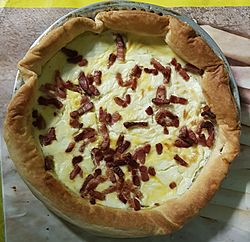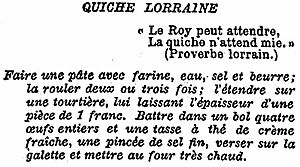Quiche Lorraine facts for kids

Quiche Lorraine served in Paris
|
|
| Type | Savoury |
|---|---|
| Place of origin | France |
| Region or state | Lorraine |
| Main ingredients | Pastry case filled with egg, cream and bacon |
Quiche Lorraine is a yummy French dish. It's like a savory pie or tart. It has a crust made of pastry. Inside, it's filled with a creamy mix of eggs, cream, and bacon or ham.
This dish was not very well known outside of the Lorraine region in France for a long time. That changed around the middle of the 1900s. As more people learned about it, cheese started to be added. Some people thought adding cheese was not the original way to make it. You can eat Quiche Lorraine hot, warm, or even cold.
Contents
The Story of Quiche Lorraine
Where Did Quiche Lorraine Come From?
Quiches first came from the eastern French region of Lorraine. The word "quiche" might even come from the German word kuchen. This word means a type of cake or tart. There are many different kinds of quiches. People in different parts of Alsace and Lorraine often say their way is the only true way to make it.
How the Recipe Changed Over Time
Originally, Quiche Lorraine was made with a bread dough crust. This was similar to the crusts used for pizzas today. But now, most people use shortcrust or puff pastry. This dish has been around since the 1500s. However, for many years, it was mostly known only in its home region of Lorraine. It wasn't often seen in big cities like Paris or in other countries.
What's Inside a Quiche Lorraine?
Classic Ingredients
The main ingredients for a classic Quiche Lorraine are eggs, thick cream, and ham or bacon. The bacon is often cut into small strips called lardons. These ingredients are mixed together to make a savory custard. This custard is then baked in the pastry crust.
The Great Cheese Debate
Many famous chefs and cookbook writers, like Elizabeth David and Julia Child, wrote recipes for Quiche Lorraine without cheese. Elizabeth David even thought that adding cheese was not how the original dish was made. She believed it was added to save money or make it easier to cook. She said a classic Quiche Lorraine, with just cream, egg, and bacon, can be "quite tricky to get right."
Some chefs in Paris started adding cheese. In 1870, Jules Gouffé added Parmesan. Later, in 1903, Auguste Escoffier suggested putting bacon and strips of Gruyère cheese in the crust before adding the egg and cream mix.
There were some tries to go back to the simple, original recipe. In 1901, a newspaper called Le Figaro printed a recipe with no cheese or bacon. Another recipe in 1904 also left out both. But by the 1930s, a very famous chef named Marcel Boulestin started adding grated Gruyère cheese. By the 1950s, using cheese became very common as Quiche Lorraine became more popular.
Modern Quiche Lorraine
Today, you'll find different versions of Quiche Lorraine. Some chefs, like Anne-Sophie Pic, add Comté. Delia Smith adds both Cheddar and Parmesan. But other chefs, like Alain Ducasse and Thomas Keller, still make it without any cheese.
When you buy ready-made Quiche Lorraine in stores, it usually has cheese. This is often Emmental or a similar type. In Britain, you might find versions with Cheddar.
You can enjoy Quiche Lorraine in many ways. It tastes great served hot, warm, or even cold.


